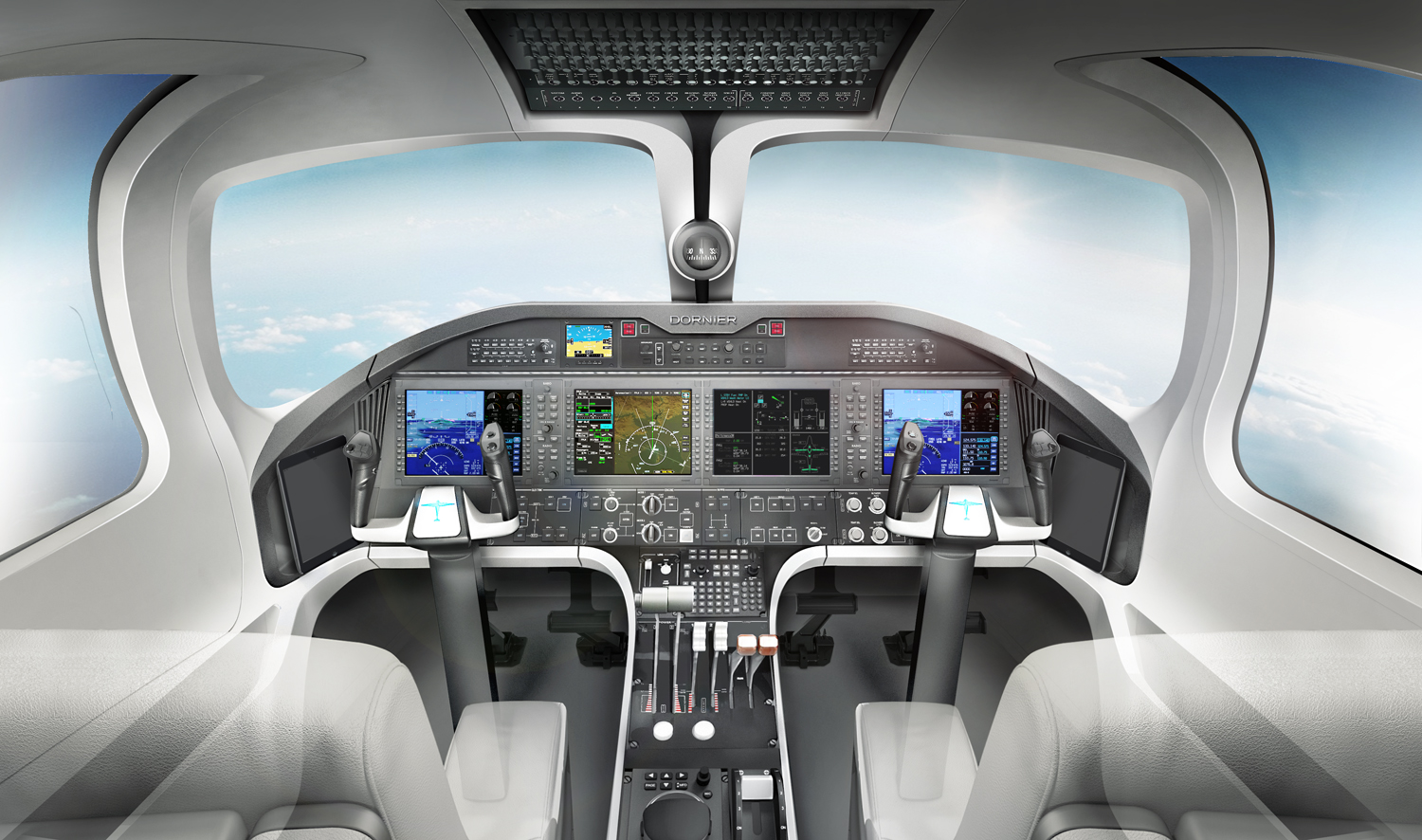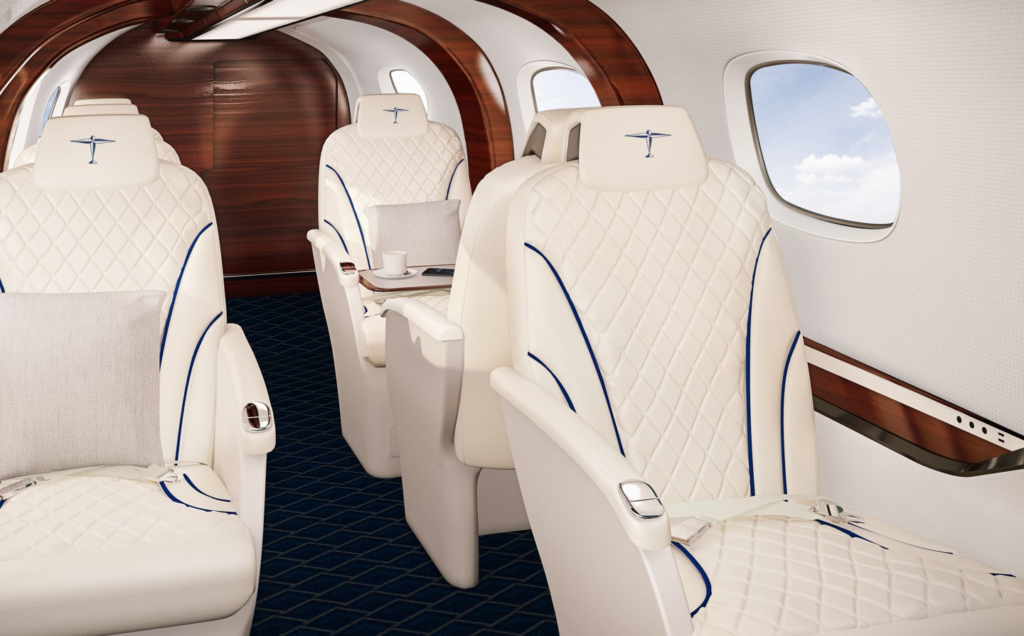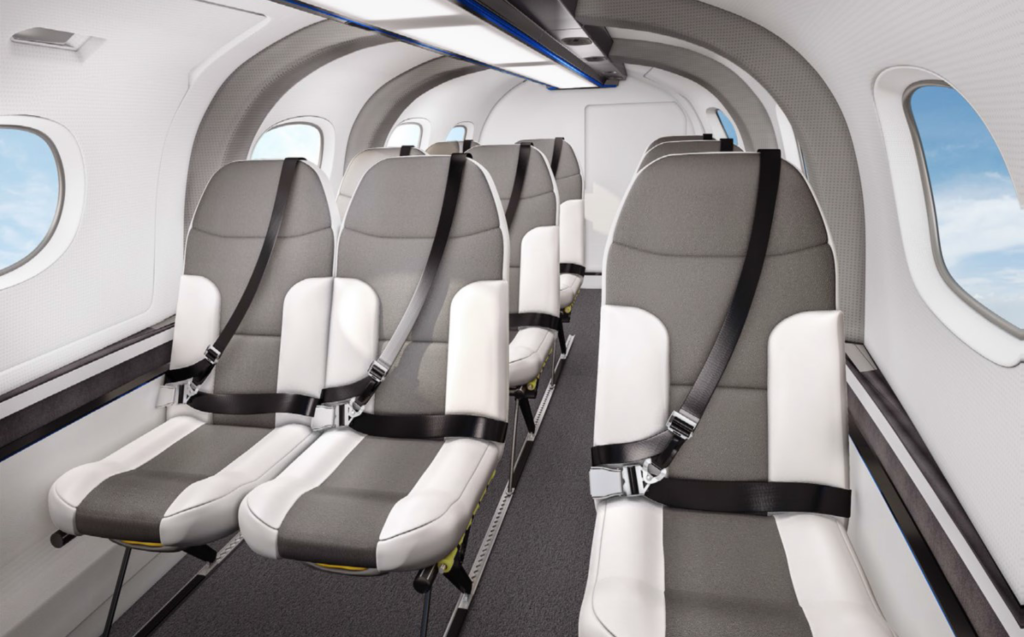Detailed Specifications* |
||
| Imperial | Metric | |
| Engines | ||
| Manufacturer | Pratt & Whitney | Pratt & Whitney |
| Model | PT6A-135A | PT6A-135A |
| Shaft Horsepower per Engine | 650 (Flat Rated) SHP | 650 (Flat Rated) SHP |
| Time between overhaul | 3600 hrs | 3600 hrs |
| Propellers | ||
| Manufacturer | MT Propeller | MT Propeller |
| Number of Blades | 5 | 5 |
| Dimensions | ||
| Wing Span | 58.20 ft | 17.74 m |
| Length | 41.67 ft | 12.70 m |
| Height | 15.52 ft | 4.73 m |
| Wing Area | 329.38 sq ft | 30.60 sq m |
| Wheel Base | 13.62 ft | 4.15 m |
| Wheel Track | 8.96 ft | 2.73 m |
| Cabin Length | 13.12 ft | 4.00 m |
| Cabin Height | 4.53 ft | 1.38 m |
| Cabin Width | 5.35 ft | 1.63 m |
| Cabin Volume | 347.20 cu ft | 9.86 cu m |
| Baggage Volume | 56.56 cu ft | 1.63 cu m |
| Accomodations | ||
| Crew Seats (One Pilot Required) | 2 | 2 |
| Passenger Seats | 0 – 12 | 0 – 12 |
| Design Weight and Capacities | ||
| Maximum Ramp Weight | 11351 lb | 5150 kg |
| Maximum Takeoff Weight | 11240 lb | 5100 kg |
| Approx. Useful Load | 2865 lb | 1300 kg |
| Baggage Capacity | 397 lb | 180 kg |
| Maximum Landing Weight – Land | 10689 lb | 4850 kg |
| Maximum Landing Weight – Water | 11020 lb | 5000 kg |
| Fuel Capacity | ||
| Usable | 363 US Gallon | 1375 l |
| Speeds | ||
| Maximum Cruise Speed (MTOW FL100) | 180 KTAS | 333 km/h |
| Stall Speed (landing configuration) | 66 KCAS | 120 km/h |
| Rate of climb @ Sea Level, ISA, MTOW | ||
| Two engines | 1079 ft/min | 329 mpm |
| Single Engine | 392 ft/min | 120 mpm |
| Performance | ||
| Maximum Operating Altitude | 15000 ft | 4573 m |
| Maximum Range (2 Crew, FL150, VFR Reserve, Max Range Power Setting) |
900 nm | 1667 km |
| Take Off Distance Sea Level, ISA, MTOW | ||
| Land (35 ft Obstacle) | 2244 ft | 684 m |
| Water (35 ft Obstacle) | 3445 ft | 1050 m |
| Landing Distance Sea Level, ISA, MLW | ||
| Land (50 ft Obstacle) | 2621 ft | 799 m |
| Water (50 ft Obstacle) | 2795 ft | 852 m |
| Sea State (maximum demonstrated but not limiting) |
2 ft | 0.6 m |
| Operation | ||
| Provisions for Single Pilot Operation IFR | Yes | Yes |
I am text block. Click edit button to change this text. Lorem ipsum dolor sit amet, consectetur adipiscing elit. Ut elit tellus, luctus nec ullamcorper mattis, pulvinar dapibus leo.
I am text block. Click edit button to change this text. Lorem ipsum dolor sit amet, consectetur adipiscing elit. Ut elit tellus, luctus nec ullamcorper mattis, pulvinar dapibus leo.
I am text block. Click edit button to change this text. Lorem ipsum dolor sit amet, consectetur adipiscing elit. Ut elit tellus, luctus nec ullamcorper mattis, pulvinar dapibus leo.I am text block. Click edit button to change this text. Lorem ipsum dolor sit amet, consectetur adipiscing elit. Ut elit tellus, luctus nec ullamcorper mattis, pulvinar dapibus leo.I am text block. Click edit button to change this text. Lorem ipsum dolor sit amet, consectetur adipiscing elit. Ut elit tellus, luctus nec ullamcorper mattis, pulvinar dapibus leo.
FEATURES
WING DESIGN
The wing is designed for slow approaches and a stall speed of 65 KCAS while still offering a maximum cruise speed of 180 KTAS. The specially designed wingtips facilitate tight turns on water and provide hydrodynamic lift support in case of contact with the water surface.
SPONSONS
The sponsons are attached to the centre fuselage section. This is an optimized design resulting in smooth water landings and short take-off runs. The sponsons houses the fuel and the main landing gear, keeping the centre of gravity at the lowest point. In addition they act as a working platform.
LANDING GEAR
A true amphibian, the Seastar is at home on land as well as on water. Its wide-track landing gear ensures smooth landings on runways. The aircraft comes with a hydraulically controlled nose wheel steering system.
ENGINES
The Seastar is equipped with two powerful Pratt & Whitney PT6A-135A turboprop engines, providing a total of 1,300 horsepower (flat-rated). Its in-line push-pull engine configuration eliminates asymmetric thrust in the event of an engine failure allowing it to continue the flight as normal. Moreover, the unique, over-wing placement minimizes the possibility of foreign object damage (FOD) and water ingestion into the engine intakes and towards propellers. The 5-blade propeller reduces vibrations and lowers cabin noise and external noise level.
MATERIALS
The Seastar’s airframe is made from all-composite material, making it corrosion free in saltwater environments and far superior to aircraft made from aluminium. Its intelligent and integrated structure is designed for long structural life and high damage tolerance, reducing maintenance cost and downtime. The unique construction of the composite airframe prevents any leakage caused by rivets and bolts as commonly experienced by metal airframes.
SHAPE
Unlike competitors with floats, the Seastar is a purpose-built flying boat. Its V-Keel shaped fuselage offers similar handling to a powerboat and allows take-off and landing in sea states with up to two-foot waves (demonstrated but not limited to). Not only does this greatly improve versatility, but also substantially enhances safety and comfort. In flight, the integrated-hull design reduces drag force, provides greater fuel efficiency. This increases payload and range.








